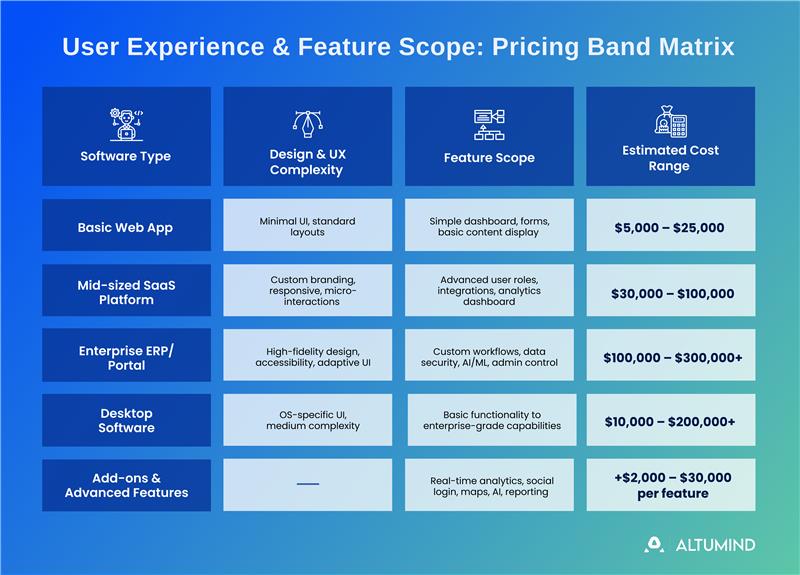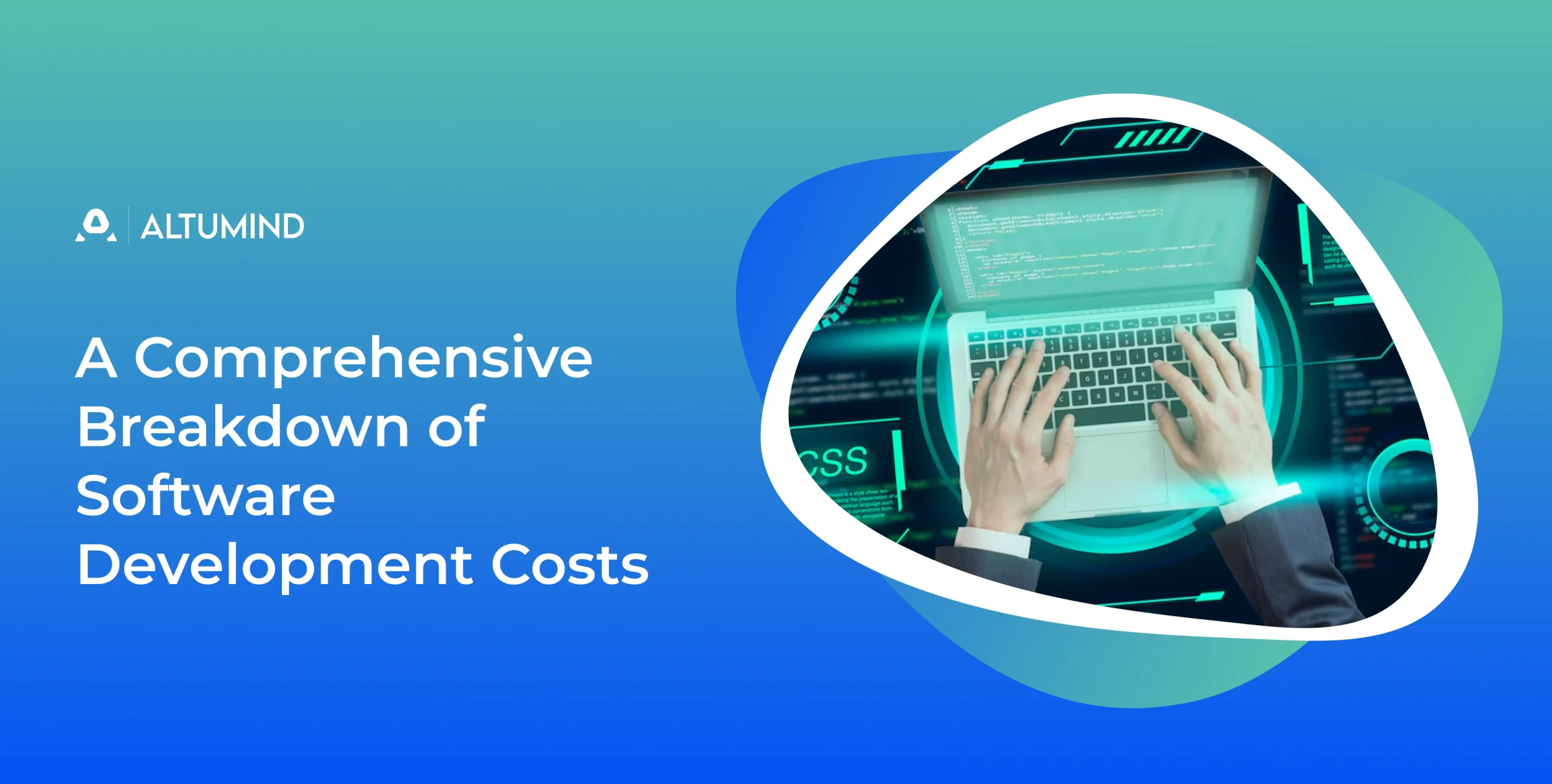Custom software development demands careful budgeting and a clear understanding of cost drivers. Whether developing a simple app or a full-fledged enterprise-level software, decision-makers can’t overlook key cost variables. Organizations overestimate or underestimate critical expenses without a structured and quantified cost breakdown, affecting quality and timeline.
Software development costs of key components help develop a realistic budget of upfront and ongoing costs, besides helping to realize how “value for money” the entire project will be. Whether you’re a startup planning your first software or an enterprise at the frontier of new software development, understanding software development costs is crucial for informed financial decisions.
Let’s dive in and break down the key factors in custom software development pricing!
Custom Software Development Pricing
1. Project Complexity and Scope:
The depth, breadth, and intricacy of a software, such as features, customization, ERP integrations, security, etc., will become the software complexity and drivers of the cost. In scope, the extent of work features objectives, functionalities, user roles, and technical requirements. These two factors primarily determine the overall project expenditure.
App Development Complexity Tiers:
- Basic: $20K-75K | 3-5 months Single platform, minimal features, standard UI/UX, no integrations
- Medium: $75K-175K | 6-9 months Cross-platform, moderate customization, API integrations, multi-user roles
- Advanced: $175K-500K+ | 6+ months Complex integrations, AI/ML capabilities, advanced security, high scalability
2. Development Time and Effort:
Development hours can increase the invoice charge. As per Full Stack, the Big business-class software development companies will charge $250 to $350 per hour. Mid-market development companies cost $120 to $250 per hour, and small-class custom software development companies cost $90 to $160 per hour. With Freelancer (newbies), it’ll cost around $50 to $75 an hour, and seasoned freelancers will cost $100 to $300.
The costs run through multiple phases, such as planning and discovery, front-end and backend development, testing, prototyping, deploying, and post-launch adjustments. As per Full Stack, enterprise-level projects cost $750,000 to over $100 million, business-class projects cost $150,000 to $5 million, mid-custom software development projects cost $75,000 to $2 million, and small projects cost $20,000 to $500,000.
3. Team Composition and Location:
The number of developers, designers, managers, and QA engineers will come to influence the final costs. But that’s not all; their location also makes a difference. The per-head costs are less offshore in Southeast Asian territories like India, Vietnam, and China, but it’ll cost you way more in North America. As per Indeed, the average Software Engineer salary in the US is around $123,400, and the same in India is $9634.
So, in-house development offers cultural symmetry, the same time zone advantage, and easy coordination, but it proves costlier. On the other hand, offshore development brings cost efficiency, a bigger talent pool, and scalability. The best part is that you can focus on growing your business. They have various engagement models, such as Retainer, BOT, Offshore Development Team (ODC), etc., and you pick the one that best serves your budget and needs.
You can also outsource to another IT firm/agency in your region, or opt for nearshoring with another firm in a neighboring country. As per Full Stack, offshore development rates can range from $27 to $55 an hour, and nearshore firms cost $44 to $82. Junior developers will cost less compared to seasoned veterans, and so will freelancers, but their reliability and availability are an issue.
If you require help setting up a cost-effective, skilled, and scalable offshore development team, connect with Altumind.
4. Technology Stack & Infrastructure Costs:
The cost of developing custom software is heavily shaped by the chosen technology stack and supporting infrastructure. Open-source languages and frameworks like Python and JavaScript reduce upfront investment, while enterprise-grade technologies such as .NET or Salesforce, along with premium databases like Oracle or Microsoft SQL Server, can introduce licensing fees ranging from $5,000 to $50,000. Integrating third-party services—such as CRMs, analytics platforms, or AI APIs—can further elevate costs depending on usage scale and complexity.
Cloud infrastructure expenses add another layer. High-traffic applications with load balancing, auto-scaling, managed CI/CD pipelines, and high-availability database hosting can cost anywhere from $5,000 to $50,000+ monthly. Additional recurring costs for CDN usage, cloud storage, domain registration, and security certificates must also be considered when estimating the total cost of ownership.
5. Security and Compliance:
Data Encryption (at rest and in transit) requires AES-256, TLS, and HTTPS implementation costing $500–$5,000. User authentication and authorization, comprising role-based access control (RBAC), OAuth2, and Multi-Factor Authentication (MFA), will cost around $1,000–$10,000. Here’s a breakdown of everything else:
- GDPR and SOC 2 Type I/II compliance framework – $5,000–$15,000 and $30,000–$100,000+
- Firewall, Intrusion Detection Systems (IDS), and DAST/SAST tools will cost $1,000–$20,000/yr
- Cloud secure S3 buckets, IAM roles, encryption, secure backups, etc., will cost $1,500–$10,000
- SIEM integration, 24/7 monitoring, alerting systems, etc., will cost: $5,000–$30,000+
6. Testing and Quality Assurance (QA):
Testing the software to ensure it functions correctly involves considerable man-hours. Manual testing typically costs $15–$60/hr, with monthly retainers starting at $1,000. Automated testing using tools like Selenium, Appium, or Katalon can reduce time-to-market but comes with initial scripting costs (~$2,000) and ongoing maintenance ranging from $500 to $5,000/month.
Performance and security testing—whether via JMeter, BlazeMeter, or basic vulnerability scans—can add $1,000 to $10,000, especially when paired with 3rd-party audits or test integrations with CI/CD pipelines. Supporting tools like Jira, TestRail, or Zephyr further contribute marginally at $10–$30/user/month. As per Statista, a panel of CIOs and senior technology professionals reported that Quality Analysis and Testing, on average, can account for 23% of their budget.
7. User Experience & Feature Scope:
Your software’s interface and functionality aren’t just cosmetic—they define how users interact, engage, and stay productive. The depth of UX/UI design, including responsiveness, accessibility standards (like ADA/WCAG), animations, and custom branding, plays a major role in shaping both cost and development timelines. A more intuitive and polished user journey often demands intricate design work, interactive prototypes, and extensive device adaptation.
Beyond design, the breadth of features determines the scope of effort. Whether it’s a basic dashboard, a full-fledged SaaS solution, or an enterprise-grade portal, the complexity of functionality—analytics, AI integrations, real-time data handling, user roles, admin controls, geolocation, or third-party API syncs—directly scales development time and cost. The more powerful and user-centric your software aims to be, the more investment it demands.

8. Post-Development Support:
The software is ready, but it’s not done yet. In the post phase, you’ll spend more on maintenance and updates, increasing software development costs. Your team will assist with enhancements and unexpected bug fixes, meaning more time and money spent cleaning up the last few issues. For instance, monitoring, logging, and observability tools such as Datadog, New Relic, Prometheus + Grafana cost $100–$500/month for basic logging (ELK stack, etc.) and $500 to $5,000/month+ for advanced monitoring (Datadog).
- Adding new features or improving existing ones
- Last-minute security patches to protect against vulnerabilities
- Performance monitoring to ensure smooth operation
- Simple automated backup is $50 to $300/month, cross-region costs $1,000 to $10,000/month
As per the IBM System Science Institute, the cost of correcting an error identified after the product’s release is 4-5 times higher than the cost of fixing an error detected during the design phase, and it can be up to 100 times greater than the cost of addressing an error found during the maintenance phase.
Wrapping Up: Software Development Costs
Navigating software development costs can be complex. You’d need all the above factors to arrive at the final estimate, which is still an estimate, as costs can vary along the way. Overlooking these critical expenses is one of the most common and costly mistakes in software development planning. Computing custom software development pricing needs an informed decision-making process. Want to achieve long-term value from the software? Make sure to optimize the budget by carefully evaluating the needs for the custom software solutions.
Looking to streamline your custom software development costs without compromising on quality? At Altumind, we tailor our pricing models to your needs while ensuring high-performance solutions that are built to scale, evolve, and deliver ROI from day one. Our software architects and experts oversee the lifecycle, from ideation to beta to launch, to create the most efficient and scalable solution for your business.
Altumind’s transparent custom software development pricing ensures your software development costs remain within your prescribed budget, and you get the best return on investment for every dime spent.


